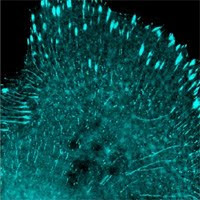The
recently published method is based on the generation of disulfide-free
“intrabodies”, a structure from the 10th fibronectin type III domain
known as FingRs. These affinity molecules were fused to GFP for direct
fluorescence miscroscopy. The FingRs do not need di-sulfite bonds and
are therefore better folders in mammalian cells. Specifically, a library
was screened with in vitro display to identify FingRs that bind two
synaptic proteins, Gephyrin and PSD95. After the initial selection, the
researchers from USC secondarily screened binders using a cellular
localization assay to identify potential FingRs that bind at high
affinity in an intracellular environment. As it turned out, only 10-20%
of the original positive clones bind well inside the cells, suggesting
this type of further screening was a critical step.
The
expression of intrabody is transcriptionally regulated by the target
protein through a ZFN-repressor fusion. This transcriptional control
system matches the expression of the intrabody to that of the target
protein regardless of the target’s expression level. This design
virtually eliminates unbound FingR, resulting in very low background
that allows unobstructed visualization of the target proteins. As
result, the FingRs presented in this study enabled live cell
visualization of excitatory and inhibitory synapses, and apparently
without affecting neuronal function.
Technically,
the reason to use in vitro mRNA display was required by the need to use
a large library (>10exp12, beyond the limit of the more commonly
used phase display) to find good binders. A similar visualization system
can be established using more potent affinity domains such as the VHH
single-domain antibodies that have only one, sometimes dispensable,
di-sulfite bond. The VHH domain nanobodies can be more easily isolated
from camelid animals. Another improvement to the visualization system
can be made by using stronger, superresolution-ready FPs such as
mNeonGreen or mMaple to enable single molecule imaging, which is
particularly interesting for studying synapses and applied to the BRAIN
initiative.



